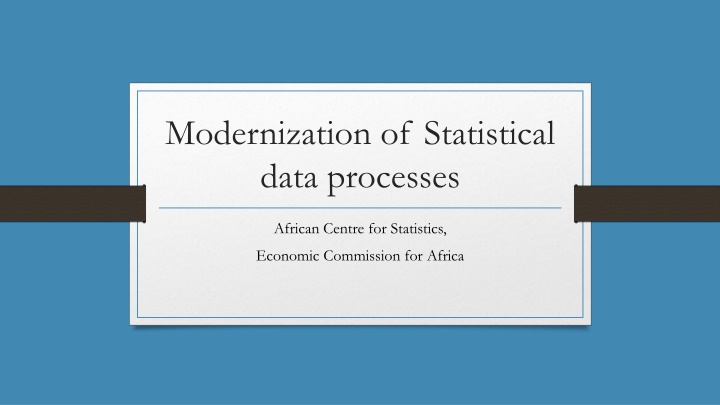
Revolutionizing Statistical Data Processes in Africa
The African Centre for Statistics and the Economic Commission for Africa are spearheading the modernization of statistical data processes to meet increased demands. This entails advancements in technology, quality assurance, metadata management, and embracing new data sources. Ensuring data quality, relevance, timeliness, accessibility, interpretability, accuracy, coherence, and punctuality are essential dimensions in this transformation journey.
Download Presentation

Please find below an Image/Link to download the presentation.
The content on the website is provided AS IS for your information and personal use only. It may not be sold, licensed, or shared on other websites without obtaining consent from the author. If you encounter any issues during the download, it is possible that the publisher has removed the file from their server.
You are allowed to download the files provided on this website for personal or commercial use, subject to the condition that they are used lawfully. All files are the property of their respective owners.
The content on the website is provided AS IS for your information and personal use only. It may not be sold, licensed, or shared on other websites without obtaining consent from the author.
E N D
Presentation Transcript
Modernization of Statistical data processes African Centre for Statistics, Economic Commission for Africa
Outline Background What is modernization Quality assurance Metadata Technology and Innovation Standards
Background Increased demands to produce statistics in quantity and quality New development agendas Data revolution New data sources for statistics Use of new technology Advancement in technology Emphasis on data analytics
Modernization the process of adapting something to modern needs or habits. Transforming the way we manage statistical processes Reengineering the processes Increased flexibility to adapt Doing more with less
Quality assurance Data quality refers to the condition of a set of values of qualitative or quantitative variables. There are many definitions of data quality but data is generally considered high quality if it is "fit for its intended uses in operations, decision making and planning". Wikipedia
Quality assurance Data quality dimension: Relevance: degree to which statistics meet users needs Timeliness: time elapsed between release of data and reference period Accessibility: ease with which statistical data can be obtained by users Interpretability: the ease with which the user may understand and properly use and analyse the data or information Accuracy: distance between the estimated value and the true value Coherence: logically connected and complete Punctuality: distance between actual and planned release dates
Quality assurance At the agency level At the programme design stage At the Implementation stage At the post-collection evaluation stage
Metadata Metadata is data that defines and describes other data. OECD Metadata is "data [information] that provides information about other data". Wikipedia
Metadata Structural metadata needed to identify, use, and process statistical data Reference metadata describe the content and the quality of the statistical data Source: Management of Statistical Metadata at the OECD , OECD, 2006
Standards and architecture GSBPM GSIM CSPA SDMX DDI
Business architecture Generic Statistical Business Process Model (GSBPM) To define and describe statistical processes in a coherent way To standardize process terminology To compare and benchmark processes within and between organisations To identify synergies between processes To inform decisions on systems architectures and organisation of resources
Information architecture Generic Statistical Information Model (GSIM) describes the information objects and flows within the statistical business process GSIM is not a software tool: It is a new way of thinking! Common Statistical Production Architecture: An statistical industry architecture will make it easier for each organization to standardize and combine the components of statistical production, regardless of where the statistical services are built
Application architecture Standard Data and Metadata eXchange (SDMX) Common data transmission format for statistical data and metadata Data Documentation Initiatives (DDI) Standard dedicated to microdata documentation; enables documentation of complex microdata files
Technology and innovation The Internet Web services/API Web 2.0 Open data/standard/sources New data sources Data analytics


